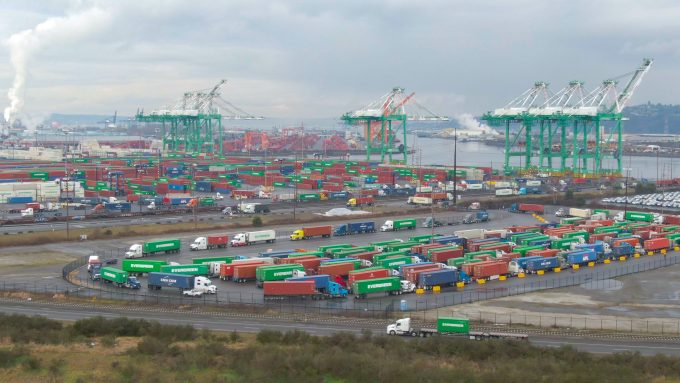Analysis: what odds a US east coast and Gulf shutdown?
Enter at your peril…

Truckers want the port authorities of Los Angeles and Long Beach to pave the way for a common platform for them to make appointments at any of the 12 container terminals at the gateway complex.
The California Trucking Association and Harbor Trucking Association stressed the benefits of a platform that would help the ports stem the loss of cargo shifting to other US gateways.
Weston LaBar, head of strategy at Cargomatic, a tech-based marketplace, noted that currently each terminal has its own ...
Asia-USEC shippers to lose 42% capacity in a surge of blanked sailings
USTR fees will lead to 'complete destabilisation' of container shipping alliances
New USTR port fees threaten shipping and global supply chains, says Cosco
Outlook for container shipping 'more uncertain now than at the onset of Covid'
Transpac container service closures mount
DHL Express suspends non-de minimis B2C parcels to US consumers
Zim ordered to pay Samsung $3.7m for 'wrongful' D&D charges
Uncertainty over US tariffs sparks interest in bonded warehouses for imports

Comment on this article
Joseph Piros
February 18, 2023 at 7:07 amI believe the main reason each terminal operators are reluctant to join a unified appointment system, is that they consider the data of how much TEU they’re moving “proprietary”.
The Federal Marine Commission should take the prerogative, and consolidate the terminal’s appointment system into one. The terminals are operating on public government lands, and should follow said order to guarantee efficiency, which is one of the FMC’s duty.
I am a carrier, but I like to work and work with the backside of the dispatch system. I see first hand all the websites they have to go on, to get the drivers where they need to go. I may have an interesting take, if the FMC can take notice. I’m one of a handful of Deaf drivers that operates in the ports. I have been having difficulties with some of these terminals because of inefficiencies introduced into the individual appointment systems. Ever since LBCT Pier E have instituted their appointment system, their system requires a working complete information entered, that if one part of the appointment is not complete, the appointment won’t be made. That way, every time I, as a driver, enter LBCT Pier E, I have NEVER had any serious problems at the terminals regarding access of their in-gate and out-gate system. Other terminals, their systems does not check for transactions errors, that would flag a clerk to reject the transaction, making communications difficult and transactions become extreme inefficient to the point of taking HOURS to sit at the in-gate or out-gate pedestal just waiting for some help.
Having a unified appointment system following LBCT Pier E’s example would guarantee that only complete and successful appointments would be created when the transaction is valid. reducing complications and fully automating the in-gate out-gate process, but still involving clerks to visually check the system is making right AI choices for confirmation.
The Deaf Driver would not have to have communications breakdown at the pedestal, since the transaction is automatically identified by the RFID tag, each truck is required to maintain for access to the terminals.
The investment to make changes in each terminal’s technology is MINIMAL, as the appointment system server technology is simple and robust enough with robust security to adapt different terminals computer systems, to work with a unified single appointment system operated by 3rd party, and overseen by each port’s authority to maintain neutrality and security of the data.
Implementing this would end my 8 year battle with the terminals to make the in-gate and out-gate pedestals more accessible for deaf drivers. When the clerk turns off in-gate out-gate automation, it defeats the efficiency it was designed to introduce. If the terminal wants to pace the queue to prevent congestion, a simple script can be introduced to the automation software to pace a driver in-gate 1 per 5 min or 1 per 10 min. etc.
Come on, lets DO this!! Tell the FMC to take notice!